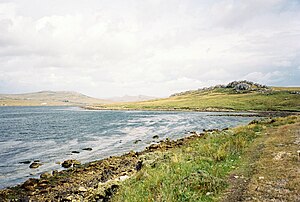Our website is made possible by displaying online advertisements to our visitors.
Please consider supporting us by disabling your ad blocker.
Battle of Mount Tumbledown
| Battle of Mount Tumbledown | |||||||||
|---|---|---|---|---|---|---|---|---|---|
| Part of the Falklands War | |||||||||
 Mount Tumbledown, Two Sisters, and Wireless Ridge, as seen from Stanley Harbour. | |||||||||
| |||||||||
| Belligerents | |||||||||
| United Kingdom | Argentina | ||||||||
| Commanders and leaders | |||||||||
|
Michael Scott John Kiszely Iain Dalzel-Job | Carlos Robacio | ||||||||
| Units involved | |||||||||
| Royal Navy |
5th Naval Infantry Battalion 1st Marine Field Artillery Battalion 1st Marine Anti-Aircraft Regiment 4th Infantry Regiment 12th Infantry Regiment | ||||||||
| Strength | |||||||||
|
641 soldiers 2 Scorpion light tanks 2 Scimitar light tanks 2 frigates |
700 marines[1] 200 soldiers[1] 3 Tigercat SAMs | ||||||||
| Casualties and losses | |||||||||
|
10 killed[2](9 Guardsmen and 1 Sapper[3]) 35[2]–53[4] wounded (43 Guardsmen, 8 Gurkhas,[5] 6 Royal Marines[6] and 3 tankmen[7]) |
30 killed[2] 30 captured | ||||||||
The Battle of Mount Tumbledown was a night battle during the Falklands War. The engagement was an attack by the British Army and the Royal Marines on the heights overlooking Port Stanley, the Falkland Islands capital.
Mount Tumbledown, Mount William and Sapper Hill lie west of the capital and due to their proximity to the capital, were of strategic importance during the 1982 War. They were held by the Argentine 5th Naval Infantry Battalion (BIM 5), a reinforced, cold weather trained and equipped Marine battalion.
British forces were the 2nd Battalion, Scots Guards, 42 Commando, Royal Marines, Mortar platoon and four light tanks of the Blues and Royals. The 7th Gurkha Rifles were held in reserve with the task of capturing Mount William held by O Company, the 5th Marine Battalion, then allowing the Welsh Guards through to take Sapper Hill. The attack was supported by gunfire from HMS Active's 4.5 inch gun.
The Argentinian forces defending the mountains around Port Stanley were Commander Carlos Hugo Robacio's 5th Marine Infantry Battalion (BIM 5). Prior to the British landings, the Argentine Marines battalion had been brought up to brigade strength by a company of the Amphibious Engineers Company, a heavy machine-gun company of the Headquarters Battalion, a battery of the 1st Marine Field Artillery Battalion, three Tigercat SAM, Six Hispano-Suiz, HS-831 30mm AA batteries of the 1st Marine Anti-Aircraft Regiment, a 2nd and 3rd Marine Infantry Battalion platoon, military police and a canine platoon.[8]
On the night of 13–14 June 1982 the British launched an assault on Mount Tumbledown and succeeded in driving Argentinian forces from the mountain. One of a number of night battles that took place during the British advance towards Stanley, the battle led to British troops capturing all the heights above the town, allowing the town's capture and the surrender of the Argentine forces on the islands.
- ^ a b Robacio: homenaje a 85 años del nacimiento de un Comandante ejemplar
- ^ a b c d Freedman, Lawrence (2005). The Official History of the Falklands Campaign: War and diplomacy. Psychology Press. ISBN 978-0-7146-5207-8.
- ^ Airborne Engineers Association
- ^ a b Falklands hero hails Magaret Thatcher’s leadership
- ^ Gurkhas and the Falklands War
- ^ Tumbledown, Wireless Ridge, & Sapper Hill
- ^ "Badly shaken, Lt Coreth, Trooper Jed Farmer and Lance Corporal 'Lamb' Chop' Lambert abandoned the stricken wagon and jumped up on our decks. We dropped them back at the bandaging station for treatment." Bullet Magnet: Britain's Most Highly Decorated Frontline Soldier, Mick Flynn, p. ?, Hachette, 2010
- ^ Argentine Ground Forces in the Falklands War of 1982, Orders of Battle & TO&E - By R Mark Davies
Previous Page Next Page


